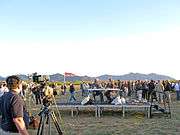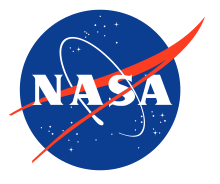NASA TV
NASA TV (originally NASA Select) is the television service of the National Aeronautics and Space Administration (NASA). It is broadcast by satellite with a simulcast over the Internet. Local cable television providers across the United States and amateur television repeaters may carry NASA TV at their own discretion, as NASA-created content is considered a work of the U.S. government and is within the public domain. NASA TV is also available via various cable, satellite, and over-the-top media services around the world. The network was formally created in the early 1980s to provide NASA managers and engineers with real-time video of missions.[3][4] NASA has operated a television service since the beginning of the space program for archival purposes, and in order to provide media outlets with video footage.[5]
| NASA TV | |
|---|---|
 NASA TV logo | |
| Owned by | NASA |
| Picture format | 720p (HDTV) 480i (SDTV) 4K (UHDTV) |
| Country | United States |
| Language | English |
| Broadcast area | North America, Europe, Middle East, Africa[1] (television) Worldwide (online) |
| Headquarters | Washington, D.C. |
| Formerly called | NASA Select |
| Website | NASA TV |
Availability | |
| Satellite | |
| DirecTV | Channel 352 |
| Dish Network | Channel 286 |
| Galaxy 13 | 127°W: 3920 V / 28.0681 / 3/4 Transp. 11 using DVB-S[2] |
| Hot Bird | 13°E: 11373 H / 27500 / 3/4[1] |
| Eutelsat 7B | 7°E: 10887 H / 30000 / 4/5[1] |
| Eutelsat 5 West A | 5°W: 12732 V / 29950 / 3/4[1] |
| Cable | |
| Available on U.S. cable systems | Consult local cable provider for availability |
| Streaming media | |
| Ustream | |
| YouTube | Live streams playlist |
| Pluto TV | Channel 694 |
The network airs a large amount of educational programming, and provides live coverage of an array of manned missions (including the International Space Station), robotic missions, and domestic and international launches. The network completed its conversion from analog to digital transmission in late 2005 following the launch of STS-114, ending a period of dual analog and digital broadcasting, although some cable television systems may still have transmitted in analog prior to the U.S. digital television transition. The satellite link uses the DVB-S system for transmission.
Channels
NASA TV operates three channels. The "Public Channel" provides 24-hour broadcasting of live and recorded events and documentaries aimed toward the general public, as well as space and science programming for schools, museums, and other educational institutions. The "Media Channel" is dedicated to broadcast news organizations and other members of the press, featuring press release video, interviews, mission press conferences and other services. The final is the "NASA TV UHD", an experimental ultra-high-definition television channel created through a Space Act Agreement with Harmonic Inc., featuring content from NASA's archives that takes advantage of the large format, with a musical audio track.[6][7] A high definition simulcast feed of the "Public Channel" was launched on July 19, 2010.[8] The "Education Channel" was discontinued in 2016, with its programming merged into the main Public Channel. The NASA TV website also provides a channel featuring continuous live footage from inside and outside the ISS, established to celebrate the 10th anniversary of the station in orbit.[9]
While NASA TV is distributed by NASA in high definition, some redistributors, such as Dish Network and DirecTV, downconvert to standard definition before delivering to their customers.[10][11]
Programming
NASA TV carries a variety of regularly scheduled, pre-recorded educational and public relations programming 24 hours a day on its various channels. Programs include NASA Gallery, which features photographs and video from NASA's history; Video File, which broadcasts b-roll footage for news and media outlets; Education File, which provides special programming for schools; This Week @ NASA, which shows news from NASA centers around the country; and NASA Edge and NASA 360, hosted programs that focus on various projects and activities within NASA. Live ISS coverage and related commentary is aired in hour-long segments throughout the day.[12]
The network also provides an array of live programming, such as ISS events (spacewalks, media interviews, educational broadcasts), press conferences and rocket launches. These often include running commentary by members of the NASA Public Affairs Office who serve as the "voice of Mission Control", including Rob Navias, Nicole Cloutier, Brandi Dean, and formerly, Josh Byerly and the retired George Diller.
Past issues with Canada's broadcasting authority
Prior to 2007, the Canadian Radio-television and Telecommunications Commission (CRTC) prohibited NASA TV from being aired by local satellite and cable providers within Canada, with the exception of specific broadcast events. Under existing CRTC rules, a cable or satellite provider had to offer a minimum amount of Canadian content from domestic Canadian companies, and the only involvement the equivalent Canadian Space Agency had with space missions involved shared American space shuttle missions at the time, along with the Canadarms. Additionally, CRTC stated in September 2000 that there simply was not enough room left under the analog television frequency allocation plan, and standards for dealing with foreign digital television signals had not been finalized.[13] On April 20, 2007, the Commission issued a notice stating that after receiving an initial request from Mountain Cablevision and support from other Canadian broadcasters and members of the public, NASA TV had been added to the list of foreign television channels available in Canada.[14]
Broadcast partnerships

NASA has used external companies to provide streaming services for internet viewers, both embedded into NASA's website and through streams branded by those companies. The variety of stream formats used have varied with the available technology and with the popularity of formats, including RealMedia, QuickTime, Windows Media, Flash Video and H.264.
In July 2005, NASA entered into an agreement with Yahoo! and Akamai Technologies to provide streaming services for NASA TV ahead of the STS-114 mission and associated Return to Flight program after the Space Shuttle Columbia disaster.[15] As of 2011, NASA has entered agreements with Ustream to provide high definition streaming of NASA TV and high definition cameras aboard the International Space Station, along with mission audio. Archives of press conferences, NASA Social events, and other events are also made available via UStream.[16] Other NASA TV programs and events are archived via the NASA TV YouTube channel.
Awards
In 2009, NASA TV received two Emmy Awards. On January 24, the Midsouth Chapter of the Academy of Television Arts & Sciences awarded NASA TV and the Marshall Space Flight Center with the Governor's Award for Lifetime Achievement in recognition of NASA's 50th anniversary.[17] On August 22, NASA TV was awarded a national Primetime Emmy Award, the Philo T. Farnsworth Award, for engineering excellence in recognition of the 40th anniversary of Apollo 11's first television broadcast from the surface of the moon.[5][18]
Broadcast television affiliates
- Note: As NASA TV is a service of the federal government of the United States, its programming is considered in the public domain for any organization or person to use as they see fit; for instance the paid programming network LifehacksDRTV and WMGM-TV uses NASA TV's educational blocks to fulfill their FCC E/I requirements to their affiliates. Due to this, this list is unlikely to be a complete list of stations carrying NASA TV, either partially or in full as a digital subchannel.
| City | Station | Channel | Owner |
|---|---|---|---|
| Barstow, California | K36JH-D | 36.1 | Brent Gaddis |
| Redding, California | KGEC-LD | 26.4 | Cooper Communications, LLC |
| Gunnison, Colorado | K13AV-D | 13.3 | Gunnison Co. Recreation District |
| Cocoa, Florida | WEFS | 68.3 | Eastern Florida State College |
| Alexandria, Minnesota | K47OQ-D | 17.1 | Selective TV, Inc. |
| Syracuse, New York | WHSU-CD | 51.2 | Renard Communications |
- Source: RabbitEars[19]
See also
- ESA Television, the European Space Agency's television service
- TV Roskosmos, the Roscosmos State Corporation's television service
- TLC, co-founded and operated by NASA in the 1970s before being privatized in 1980
References
- Ecuer, Marie-Sophie (April 12, 2018). "NASA TV HD and NASA TV UHD distributed on Eutelsat satellites" (Press release). Eutelsat. Retrieved August 15, 2018.
- "NASA TV on Satellite Galaxy 13". NASA. October 6, 2016. Retrieved March 14, 2017.
- McAuliffe, Tom Patrick (September 2007). "The Video Horizon". Digital Content Producer. Archived from the original on October 15, 2008. Retrieved December 31, 2009.
- Heimberger, Mike (July 12, 2005). "NASA Digital Conversion Information". NASADigitalTV.com. Archived from the original on July 14, 2011. Retrieved July 16, 2010.
- Smith, Yvette (August 20, 2009). "NASA Television Receives Philo T. Farnsworth Primetime Emmy Award". NASA.gov. Retrieved January 1, 2010.
- "NASA TV UHD Channel Access Information" (PDF). NASA/Harmonic. April 11, 2017. Retrieved June 9, 2018.
- Dunbar, Brian (July 15, 2010). "Digital NASA TV". NASA.gov. Retrieved July 16, 2010.
- "NASA Television Debuts Full-Time High Definition Channel" (Press release). PR Newswire. July 15, 2010. Archived from the original on December 26, 2010. Retrieved July 16, 2010 – via HDTV Magazine.
- Wilson, Jim (January 29, 2010). "Live Space Station Video". NASA.gov. Retrieved July 16, 2010.
- "Channel Guide" (PDF). Dish Network. 2018. Retrieved February 11, 2019.
- "Channel Lineup" (PDF). DirecTV. 2017. Retrieved February 11, 2019.
- Wilson, Jim (April 6, 2010). "NASA TV Schedule". NASA.gov. Retrieved July 16, 2010.
- Anderson, Stephen (September 20, 2000). "NASA TV: Banned In Canada?". Space.com. Archived from the original on February 10, 2001.
- Secretary General (April 20, 2007). "Broadcasting Public Notice CRTC 2007-43" (PDF). Ottawa: Canadian Radio-television and Telecommunications Commission. Retrieved December 15, 2009.
- Dunbar, Brian; Mirelson, Doc (July 12, 2005). "NASA Signs With Yahoo! and Akamai To Bring Shuttle Mission Online". NASA.gov. Retrieved October 30, 2011.
- "Amendment to Ustream.tv's Terms of Service Applicable to Government Users/Members" (PDF). Webcontent.gov. September 25, 2009. Archived from the original (PDF) on April 4, 2012. Retrieved October 30, 2011.
- Cabbage, Michael; Storey, Angela (January 22, 2009). "NASA Television Honored by Midsouth Emmy Chapter". NASA.gov. Retrieved July 16, 2010.
- "NASA Wins Emmy for Apollo 11 Moon Broadcast". Space.com. August 20, 2009. Retrieved January 1, 2010.
- "Stations for Network - NASA". RabbitEars. Retrieved March 14, 2017.
External links
| Wikimedia Commons has media related to NASA TV. |
